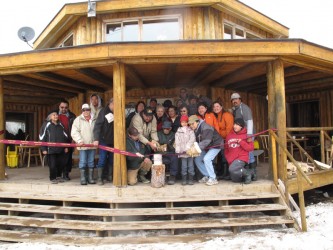Article Origin
Volume
Issue
Year
Despite an early thaw, and concerns that the river would be impassable, organizers of the grand opening of Washow Lodge on the shores of the Harricanna River near Moose Factory Island breathed a sigh of relief when bush planes arrived with officials for opening ceremonies held on March 31.
The Moose Cree’s long-awaited lodge and outdoor centre will host guests in the early summer if all continues to go well.
The opening ceremony and ribbon-cutting took place on the snow-covered ground facing the lodge just as the first geese of the season flew overhead.
“A good sign,” said Sinclair Trapper, master of ceremonies and chief operating officer for the lodge.
Twenty-three members of the Echum family on whose trapline the lodge is built gathered on the verandah for the ribbon cutting ceremony.
Ninety-four-year old Charles Brodie Echum, one of the last of the nomadic Crees, cut the ribbon with a ceremonial axe on a slab of wood. After a prayer spoken in the Cree language by Eva Lazarus, guests assembled in the lodge’s pine-paneled dining room for a traditional feast, speeches and a slide show.
Rick McLeod Farley, development consultant, read a speech prepared by Bert Wapachee, the former Economic Development Officer. He had kept the project together for the 13 years of development, but was unable to attend the opening because of family reasons. Wapachee’s speech included an homage to committee members who had passed, his fond memories of hunting geese, ducks, rabbits and partridge in the lodge area and his hopes for the lodge’s future.
The lodge land was originally owned by the Ontario Northland Railway and used as a goose camp. It was sold to the Moose Cree in the early nineties. From these beginnings an action plan developed. His hopes for the project will be that it is a place of discovery, not only for tourists, but also for his own people.
He explained that during the planning stages elders spoke of their longing to get out on the land. Single-parent families wanted Cree cultural exposure for their children. Wapachee hopes to address these mutual needs by using the property as a cultural retreat, a conference centre for local and neighboring bands, as well as for a northern experience for tourists.
He noted that marketing to the vast European market, which is estimated at 10 million people who want to experience Aboriginal culture, signifies a positive future for the lodge. But he warned that the lodge must deliver a high quality visitor experience and he anticipates it will take at least two years to tap this market.
A feast of traditional foods that included moose stew with vegetables and dumplings, goose roasted over a spit in a tipi, beaver, and savory bits of moose entrails, accompanied the speeches.
The building is designed in the shape of a bird with outstretched wings with the pine lined dining area and up-to-date kitchen located where the bird’s tail feathers might be. Bedrooms are furnished with queen-sized beds, sometimes two to a room, a small wood burning stove and a private bathroom with a composting toilet.
The entire building is extremely eco-efficient with extensive use of solar heat and heavy insulation,
Until the summer when they anticipate their first guests, the Washow development committee will be preparing programs and tours to give tourists a true northern experience. With the assistance from Fed North, a training program has been in place for young people from the Moose Cree First Nation reserve to learn hospitality skills that include housekeeping, serving, property maintenance and tour operations.
One of the young guides explained that in his course he learned how to take guests into the bush to discover animal tracks, where guests will find the best bird sites and fishing spots. He will be a guide on boat trips in summer and in winter take guests out snow shoeing, cross country skiing, and to ice fishing spots.
Yet to be finalized is the most economical way to bring guests into this isolated site on the Harricanna River.
Funding for Washow Lodge has been supplied by federal and provincial agencies and band funds.
- 2844 views

